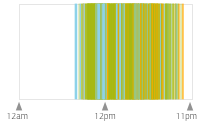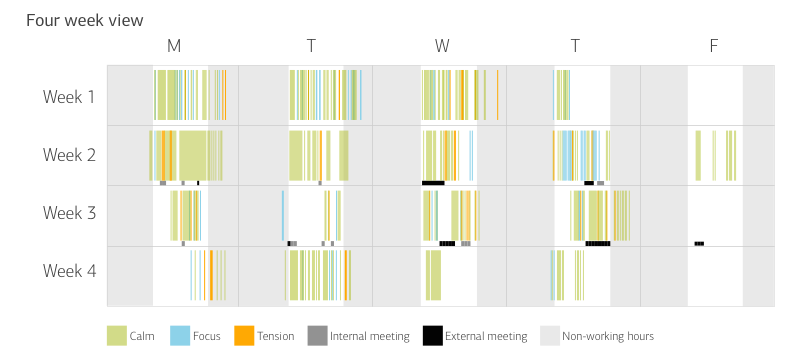Part 1: Spire Tension Experiment

Despite the positive feelings associated with running a business for the past six years, I have realized that matters tend to lean on the more—not less—stressful side. The result of this is a peak in tension and anxiety levels at critical times. My desire to control these levels helped make my decision regarding which wearable device to test out an easy one, as there were only a few products in the market that claimed to help reduce stress and tension. Of these, I chose the Spire.
My first task for my Spire experiment was to record a series of assumptions about my own behavior prior to wearing it so that after a month I could compare these assumptions to what the Spire was actually recording about my behavior. Note: As a larger working assumption I’ll assume Calm and Focused are positive, and Tension is a negative (although this isn’t explicit with the Spire).
Assumptions:
- Calm: I would rarely be calm during the work day, but would be very calm in the evenings. I expect that “Calm” will not be reported all that often.
- Focus: I would be most focused in the morning and late afternoon, and early week and late week. I would tend to lose focus after work. Focus would be the highest reported data point.
- Tension: Tension would be spread throughout my work day but rise during client calls, sales work, or presentations. Limited tension in the evenings. Tension would be moderately reported.
Note: While the Spire does track activity, I am not tracking or recording that information.
Spire Wearable Data Visualizations



Assumptions Not Validated:
- Calm: The Spire shows that I’m calm a lot, which came as quite a surprise. I am calm on and off during the day, but have larger blocks of calmness in the morning hours. I also run a Gmail script each month that records when I send and receive the most emails, and it roughly follows this same pattern (majority sent in the morning and trickle out in the evening). Calmness is the largest recorded data point and the Spire often sends encouraging notifications that applaud my calmness.
- Focus: I’m not focused very often, but when I am, it is mostly during work in the early afternoon. It’s been awhile since the Spire found me focused. This was a surprise given my assumption.
- Tension: The Spire almost never records me as “Tense,” which I find very surprising. The times of tension generally happen in the very late afternoon right before the end of the work day. One great part of the Spire is that if I am tense, the wearable itself will pulse on its own (regardless of whether it’s connected to the mobile app). This is an impressive feature. As for my assumption that I would generally be more tense during client meetings, that proved to be partially true. The part that was a surprise was that I was tense more often during internal meetings than during client meetings.
Assumptions Validated:
- Focus: It is fairly clear from the data that while I am sometimes focused at work, I am rarely focused after I leave the office. Maybe this is a good thing.
- Tension: The Spire found that my tension levels rose during meetings. In fact, over the course of two weeks, roughly 70% of the recorded tension happened during meetings. As noted above, however, the majority of those recordings came during internal meetings. I have a small sample size, though, and the data is pretty surprising, as almost never has an internal meeting at Fuzzy Math felt tense.
Limitations:
From what I can tell, the Spire can only record one of these responses at a time. So I cannot be both calm and focused or focused and tense, although I would assume both of the feelings are possible at the same time.
As my overall goal is to reduce tension, I like that the Spire pulses when I’m tense. However the minimum threshold is five minutes of tension, which means things are going really, really wrong. I would have hoped to have it set to one or two minutes.
Takeaways
My takeaways are that Calm and Focus might be hard to distinguish for the Spire and that it is overcorrecting towards Calm when many of those times might be periods of Focus. Spire claims seven years of science behind these classifications, but as an everyday user, I don’t quite trust what I’m getting. I also love that the Spire will pulse on its own when I am tense and doesn’t require the phone app to be running.
Over the course of six weeks (and counting) with the Spire, I have had some of my assumptions corrected, but I find myself not trusting the data I am getting. This means I haven’t learned enough about my behavior patterns to start changing them. And if my goal was to be less tense here in the office, given the small sample times of recorded tense events, I am not sure my overall tension has been able to go down much. Or perhaps it has and I’m not privy to how long and how many times I was tense prior to this trial. In all, I would like to see no—or at the most, very minute—periods of tension.
So my next step is to try to use some of the tools within the device to help me with concentration and breathing so as to keep Focus and Calm up, as well as to see if I can get Tension further down.
Part 2: Spire UX Evaluation
Let me move on to Part 2, a quick user experience evaluation of the wearable device itself. While I believe the most important part of this review is whether it is helping people change their behavior patterns, it’s also important to keep in mind the practicality, usability, and utility of the device itself.
What Works:
- Wearable design: The smooth stone is really well designed, but not overly designed. The belt clip is a bit tight, which can make it challenging to take the wearable off, but the comfort is really impressive. After day one, I never noticed that I was wearing it.
- Breathing rate: From the moment I got the device, I was impressed with how sensitive it is to my breathing. What it does with that data is another question, and something I cover below.
- Charger: The charger is aesthetically pleasing and wireless charging is pretty nice (in the short term).
- Battery reminder: It’s nice to have a device preemptively tell me to plug it in and charge.
- Tension alerts: The Spire will pulse three times when it senses tension and provide an instant reminder to focus on your breathing. This might be the most useful part of the wearable although, as I’ve mentioned above, it doesn’t tell me that I’m tense as often as I feel.
What Needs More Work:
- Set-up: For some reason, the Spire must be upside down in order to charge. If you don’t figure this out during set-up it won’t connect to your phone. There is a small light that signifies it’s working but I wasn’t aware of this.
- Data: While I believe that the data is internally consistent (e.g. it reads the same breathing in the same way every day), I’m not sure it’s an accurate portrait of my state of calm, focus, or tension. There are times when I know I’m feeling anxious and the Spire records this as though I am calm. In fact, it records me as calm more often than anything else and says I’m rarely focused. This isn’t quite mapping with my personal record of the day.
- Charger: Wireless charging is really neat until you realize you still have a cord, it just goes into a charging station. And if you want to travel with that charger you need to bring the cord and the station. I now wish there were a Micro USB port instead of a wireless charger.
- Battery: The battery life is decent, but given the lack of a mobile charger it runs out fairly often.
- Memory/Storage: The Spire only holds about six hours of data, which means it needs to be synced twice a day to keep track of everything. Inevitably, I only have time to get it synced once a day, so I am losing a lot of data (see next bullet point).
- Syncing: Why most wearables require people to turn on USB is beyond me. Why wearables rely so heavily on a mobile phone in general is bothersome. Basically, without my iPhone the Spire would be useless. And in order to make up for the six hours of storage, I have to turn on bluetooth on my phone a few times a day for it to sync. And this sync takes so long that I forget bluetooth is on and run down my phone battery. When I’ve used a FitBit in the past, the desktop app and connector seemed odd, but now I understand perfectly why it is needed. I would prefer to plug my Spire into a Micro USB which would then plug into my computer, handling charging and syncing in one step.
Is the Spire Meeting My Expectations?
Overall the Spire is a well designed and well built device that, nonetheless, misses the mark in memory and syncing capabilities. More importantly, the data it records isn’t matching with my own interpretation of the experience. Either the device is inaccurate or I am. I’ll attempt to settle that conundrum in the coming weeks.